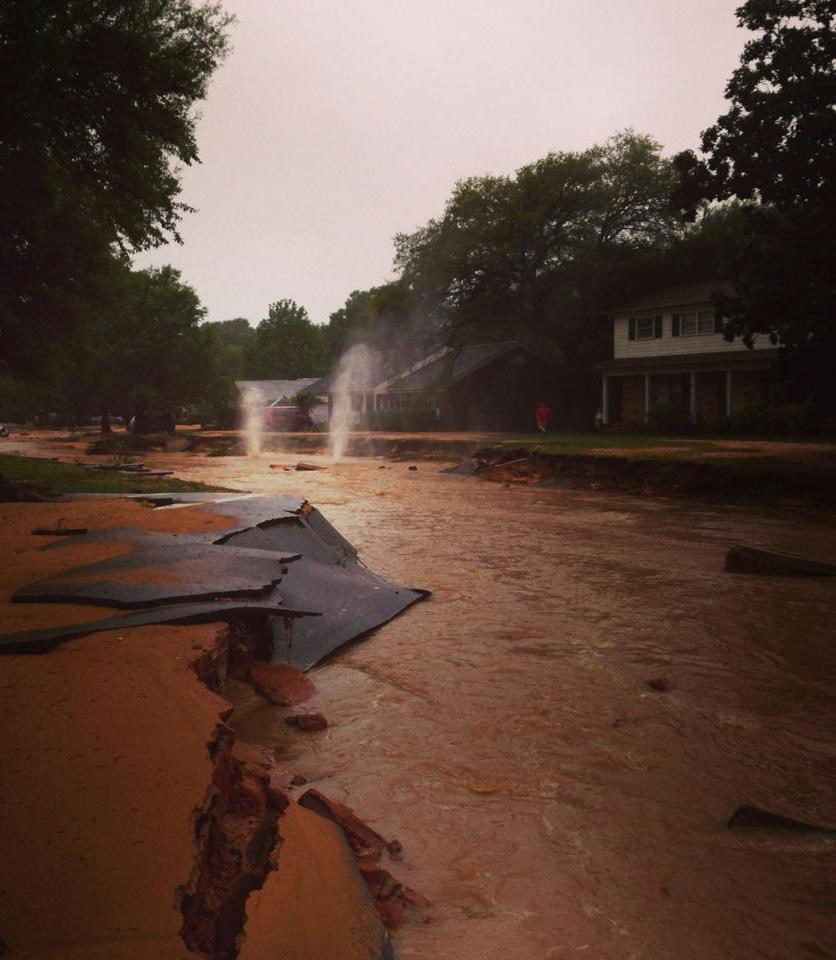
by Carrie Stevenson | May 6, 2015
Just over a year ago, southwest Alabama and northwest Florida experienced a devastating storm that left hundreds without access to their homes and businesses, flooded out and stranded by a hurricane-force storm that didn’t come with the luxury of a week’s warning. Rainfall records in Pensacola go back to 1879, and the April 29-30 storm broke them all, estimating just over 20 inches over the two days. Not only was the rainfall heavy, but the torrent was high in both velocity and volume—at one point, a mind-boggling 5.68 inches fell in the span of one hour. That’s half the annual rainfall of many cities in California and Texas!
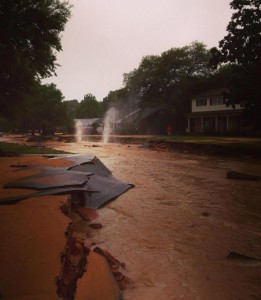
A residential street in Pensacola became a raging river a year ago during the torrential floods, putting dozens of people out of their homes. Photo credit: Carrie Stevenson UF/IFAS Extension.
With every dark storm cloud comes a silver lining, though, and just like the millions pumped into our regional economy from oil spill-related fines, the April 2014 floods have awakened a “greener” ethic among many residents, business owners, and politicians. According to a study just released by an environmental consulting firm, when asked about infrastructure changes and improvements to flooding and stormwater, attendees at community meetings overwhelmingly preferred “low impact” solutions such as expanded green space, cisterns, rain gardens, and stream restoration to “hard” structures such as bigger underground pipes and more pumps. While traditional engineering infrastructure is still crucial to a community that must maintain roads, stormwater ponds, and buildings, I find it encouraging that residents are interested in trying different techniques that have proven successful both here and in other parts of the world.
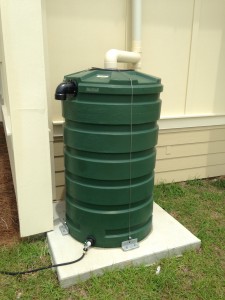
The new Langley Bell 4-H Center has four large rain barrels around the building, used to collect roof runoff for landscape design. Photo credit: Carrie Stevenson UF/IFAS Extension.
So, how does one prepare for unexpected rain and floods? The first thing is to realize that northwest Florida receives the most annual rainfall (over 60”) of any region of the state, and sometimes it seems to come down all at once. Preparing landscapes to handle both frequent and heavy rains is an important place to start. This article will begin a series of articles delving into those “low-impact” stormwater management techniques that can help lessen the impact of the intense storms we experience here in northwest Florida. Many of these practices, such as creating mulch pathways, harvesting rainwater, and installing shoreline vegetative buffers, can be implemented by individual homeowners and help reduce the impact of flooding on a neighborhood and city-wide level
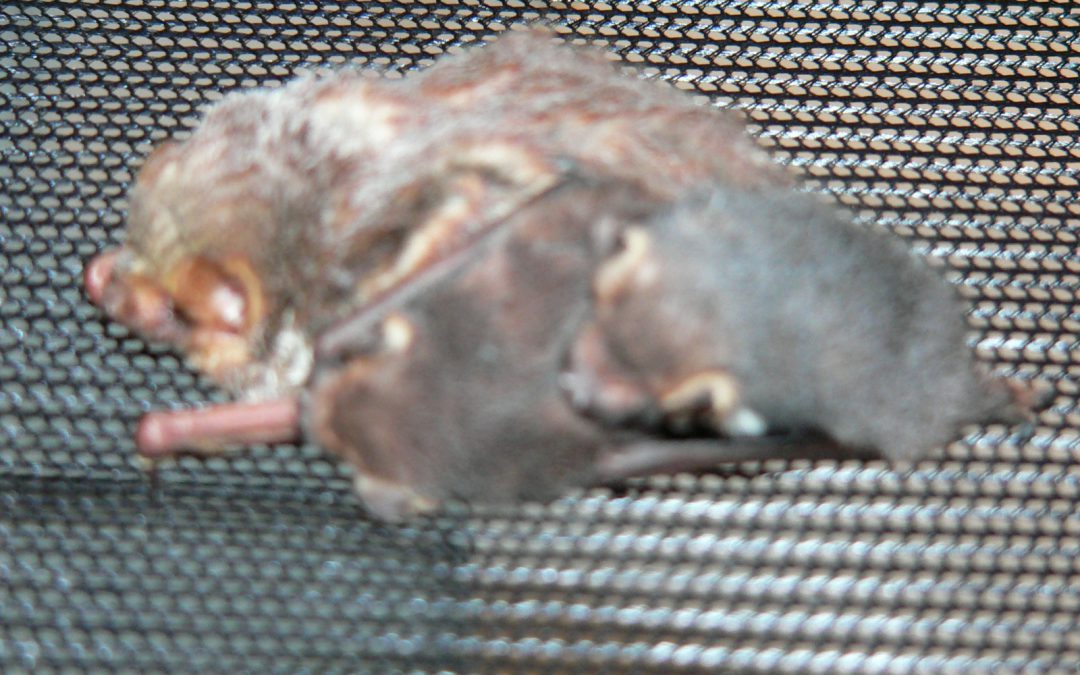
by Carrie Stevenson | Apr 7, 2015
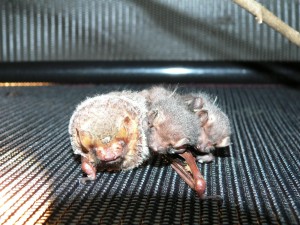
These young Seminole bat pups were separated from their mother and extremely vulnerable in the wild. The local Wildlife Sanctuary nursed them to health. Photo credit: Carrie Stevenson
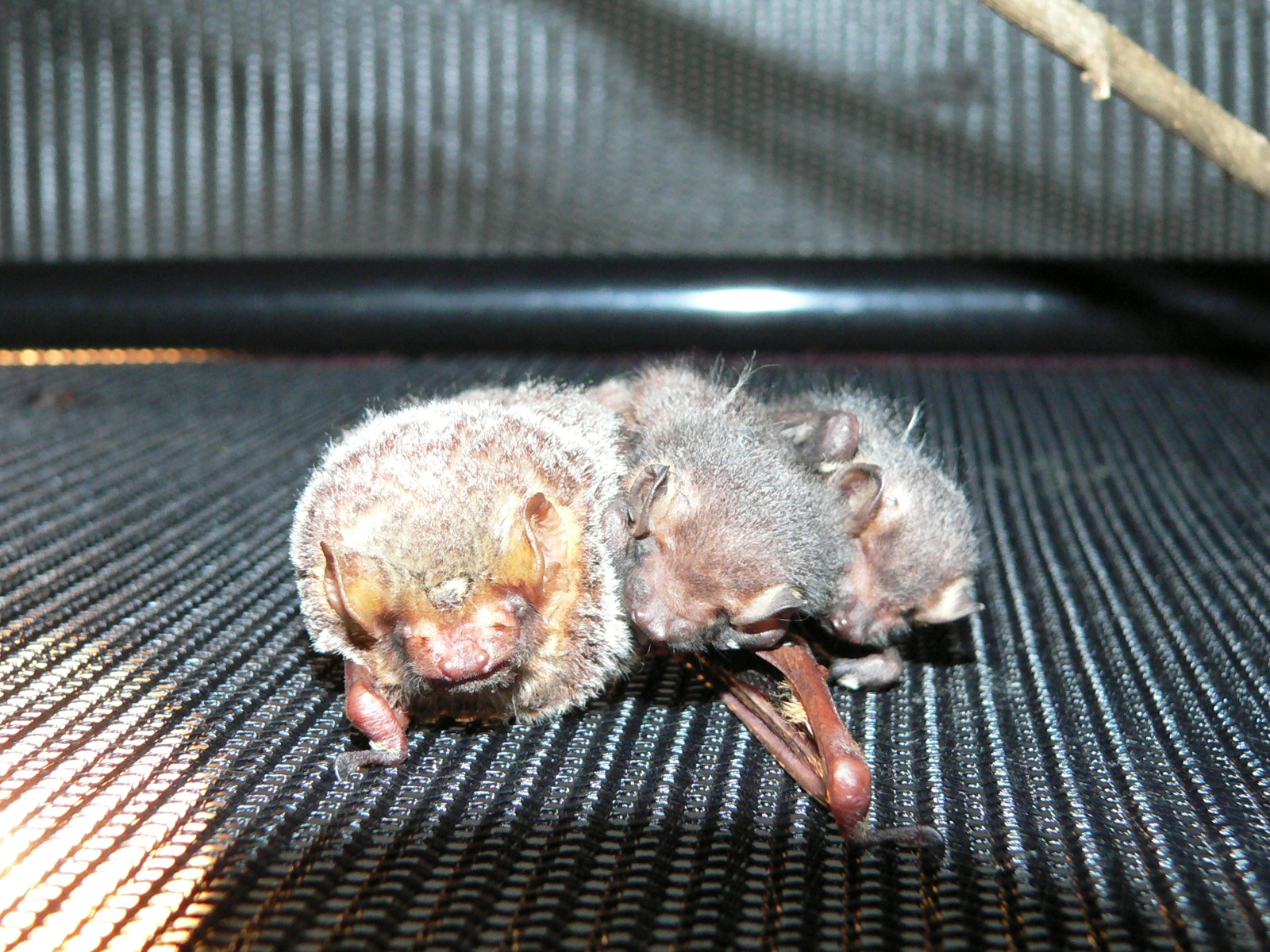 As spring commences and young wildlife of all species are born, everyone’s favorite flying, furry mammal begins roosting season. Ideally, bats will find homes in trees, caves, abandoned buildings, and bat houses, but sometimes they end up in a home. I receive calls often about how to best remove or exclude a group of bats living in an attic or garage. While there are countless benefits (most notably, efficient insect control) to having bats in one’s landscape or neighborhood, most people prefer they not share their own home with them.
As spring commences and young wildlife of all species are born, everyone’s favorite flying, furry mammal begins roosting season. Ideally, bats will find homes in trees, caves, abandoned buildings, and bat houses, but sometimes they end up in a home. I receive calls often about how to best remove or exclude a group of bats living in an attic or garage. While there are countless benefits (most notably, efficient insect control) to having bats in one’s landscape or neighborhood, most people prefer they not share their own home with them.
Bats have a slow reproductive cycle and declining populations in the United States, and are protected by several state laws. According to Florida Administrative Code 68A-9.010 under “Taking Nuisance Wildlife,” it is illegal in Florida to prevent bats from returning to any roosting location from April 16 to August 14. Female bats typically give birth during maternity season to one pup (or rarely, 2-3), which clings to the mother’s fur to nurse for their first few weeks and months of life. Being nocturnal, this means mothers and babies will be inside a dwelling during the day. Typically, if a homeowner is trying to exclude bats from a home, they will put up netting or seal a hole in an attic entry in the evening after bats have flown off to feed on insects at night. However, if this is done during roosting season, young bats left back in the roost while mothers are hunting can get trapped inside a building and will not survive.
This obviously has the potential to cause conflict between homeowners and the bat population. The Florida Fish & Wildlife Conservation Commission has regulatory oversight for bat-related issues, and they will work with citizens to arrange a positive outcome for both the property owner and the animals involved. Bats play an important role the ecosystem as efficient controllers of insect populations.
Unfortunately, bat populations are declining in North America due to a devastating disease called white-nose syndrome and loss of habitat. However, you can help these fascinating animals by installing a bat house in your yard. Keep in mind that bats attracted to bat houses prefer to be in open areas away from trees (where their predators hide), and the house should be installed at least 12 feet in the air. Bat houses can be purchased or built rather simply—keep an eye out for Extension workshops near you, or visit the UF Wildlife Ecology publication, “Effective Bat Houses for Florida” or Bat Conservation International’s website for simple instructions.
To learn more about bats and how to help them, visit this website or contact me or your local County Extension office!

by Carrie Stevenson | Mar 17, 2015
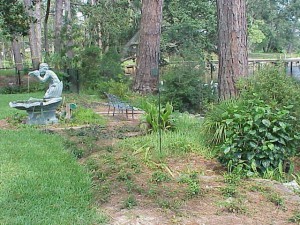
A waterfront buffer zone may include a raised berm with native vegetation to slow runoff from a yard before entering the water. Photo credit: Carrie Stevenson
A taste of spring weather has arrived, and people will soon be filling the home improvement stores and getting ready for outdoor projects. If you live on the water or near a storm drain, it’s worth considering buffer zones and best management practices for fertilizing and lawn maintenance.
A waterfront buffer zone is an area the length of one’s property line, typically running about 10 feet (although it can be wider) from the edge of a shoreline (or even a storm drain) into the yard. In this area, the homeowner allows native vegetation to grow along the water and uses low-maintenance plants within the buffer. In this zone, no fertilizers or pesticides are used. Some homeowners will build a small berm to divide the area of maintained lawn (uphill) from the downhill waterfront side. This berm may be composed of a mulched area with shrubbery to catch and filter runoff from the more highly maintained lawn. This combination of actions helps treat potentially polluted stormwater runoff before it reaches the water, and keeps homeowners from using chemicals close to the water. It is often quite difficult to grow turf next to the water, anyway, and this takes the pressure off of someone trying to grow the perfect lawn down to the water’s edge. The buffer zones are often quite attractive and can be an excellent transition between managed turf and the waterfront.
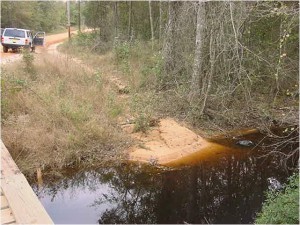
Unmaintained dirt roads along creeks are significant sources of sediment, which can harm the bottom-dwelling insects that form the base of the food web. Photo credit: Carrie Stevenson
Erosion prevention is crucial along waterways, as well. An open, non-vegetated lot can contribute a significant amount of sediment to a storm drain, stormwater pond, or natural body of water. Whether grass, trees, or bushes, any kind of vegetation is preferable to soil washing out of a yard and into the water. Sediment is a problem because it causes water clarity to drop, which can prevent seagrasses from getting the sunlight they need. Once settled, underwater sediment can form a stifling layer that chokes out small insects and invertebrates, which live in the soil and form the basis of the aquatic food chain. With no fish food available, fish may die or move out of an area. The most dramatic examples of this can often be found at dirt roads that cross over creeks. If not managed properly, the clay on these roads can nearly bury a small stream.
Other lawn care techniques for protecting the waterfront and preventing stormwater pollution include not mowing along the water, using a deflector shield and staying 3’-10’ away from the water’s edge when fertilizing, and not allowing grass clippings to blow into storm drains. Large amounts of decaying grass in a waterway can use up available oxygen, endangering aquatic organisms. When applying granular fertilizer, be sure to sweep up any spills on concrete so it doesn’t run into a storm drain. When cutting grass, mow at the highest height recommended for your turf to encourage deep rooting and stress tolerance. Healthy turf is better able to withstand drought, pests, and choke out weeds, reducing the frequency of pesticide and water application.

by Carrie Stevenson | Feb 10, 2015
After storms and when homeowners are doing “spring cleaning” around their yards, Extension agents are routinely asked about whose responsibility it is to maintain a tree along a property line. This becomes particularly important in a situation where a property owner’s tree or branch falls and causes damage to their neighbor’s home or possessions.
To clarify this often contentious issue, reference to legal experts is necessary. In a series of publications called “The Handbook of Florida Fence and Property Law,” two attorneys and a University of Florida law student explain several statutes that give us direction. The section on “Trees and Landowner Responsibility” goes into further detail and cites case-law, but for ease of reading it is summarized below.
Situation 1: Removing a healthy tree on a shared property line.
If two neighbors share a tree on their property line and one of them wants to remove it, the adjoining landowner must give their permission. Removing trees can impact property value, heating/cooling bills, or aesthetic value. Without a neighbor’s consent, the landowner cutting down a tree can be legally liable for damages.

Hurricanes can have serious impacts on trees in their path. Photo credit: Pensacola News Journal
Situation 2: Responsibility for overhanging branches and roots.
Let’s imagine a big spring storm hits your neighborhood, with tons of rain, wind, and lightning. You wake up in the morning and see that a large branch fell from your neighbor’s tree and crushed your kids’ basketball goal. If branches from the neighbor’s tree were otherwise healthy, they are not responsible for any damages resulting from the tree. If it was dead, however, and their negligence contributed to the branch falling, they will be responsible for damages.
Keep in mind that if the neighbor’s tree/branches/roots are in good health but interfering with something in your yard, you may trim them at your own expense. The same goes for your tree hanging in their yard, so while it’s not required, it’s always good to have a conversation first to let them know your plans.

After Hurricane Ivan, this tree’s root system completed uprooted and destroyed and adjacent fence. Photo credit: Beth Bolles
Situation 3: Hurricane Ana, the first big storm of 2015, blows your neighbor’s tree over, into your yard.
Just like the situation with branches and roots, the same principle goes for an entire tree falling on adjoining property—if the tree was alive, it’s the responsibility of the person whose yard it fell in. If it was dead when it fell, it’s the responsibility of the tree’s owner to pay for damages.
In a complicated situation involving property damage, the saying, “good fences make good neighbors” only goes so far. Be sure to note the health of your trees throughout the year and trim back dead or dying branches. If you see serious decay or have concerns about a tree’s health, contact your county Extension office or a certified arborist. Finally, if the circumstances aren’t easily determined, be sure to contact a licensed attorney and/or your insurance company for direction.

by Carrie Stevenson | Jan 13, 2015

Planting a tree is an excellent way to insure clean air and water in the future. Photo credit: Carrie Stevenson
Most of us begin a new year with resolutions–to exercise more, to eat right, to spend our time more productively–but few things have as many lasting impacts for the future as the simple act of planting a tree.
Arbor Day (which literally means, “Tree Day”) was founded in 1872 by J. Sterling Morton, a naturalist and journalist in Nebraska. By 1882, it was celebrated by thousands of schoolchildren nationwide, who planted trees and took care of them with their classmates. Today, millions of communities and schools celebrate Arbor Day all over the world. Trees provide endless benefits, including shade, recreation, food and building products, shade and wind protection, wildlife habitat, oxygen production and carbon dioxide uptake.
Arbor Day is typically celebrated in the United States on the last Friday of April, but as ideal tree-planting conditions differ by climate, each state has its own specific Arbor Day, as well. Winter is the ideal time to plant trees in Florida, because it allows roots to develop without expending energy on growing new leaves and shoots. Our state celebration this year is January 16th.
Many local communities in Florida hold special events around this time. Be sure to check with your local Extension office or Native Plant Society chapter to find out if they are offering free trees or public events this month. For more information on the best trees for your area, be sure to take the time to read “Native Trees for North Florida” or peruse the UF Environmental Horticulture web page.













